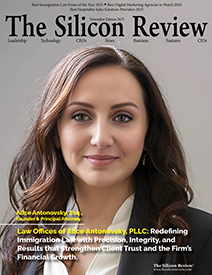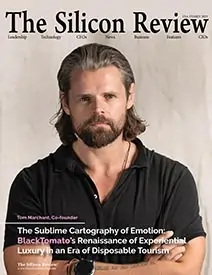10 Fastest Growing Semiconductor Companies 2016
Saankhya Labs: Industry Leader in Producing Software Defined Radios
The Silicon Review
![]() “Based in Bangalore, India, Saankhya is developing World’s First Software-Defined Universal Demodulator IC for Digital and Analog TV reception.”
“Based in Bangalore, India, Saankhya is developing World’s First Software-Defined Universal Demodulator IC for Digital and Analog TV reception.”
Operational since 2007, Saankhya Labs, the industry leader in software defined radios (SDR), is the supplier of cost effective Cognitive SDR Chipsets and White Space Network Modules for anytime, anywhere connectivity. Cognitive SDR enables intelligent user environment sensing and re-programming the modulation standards based on user requirements for minimum interference while using the available spectrum and bandwidth. Saankhya Labs SDR chipsets enable feature update, performance improvement and potentially support emerging standards by simple firmware upgrade. It also helps to debug and fix any field issues without the need to recall the product back to factory, saving precious time and cost.
Saankhya Labs SDR Chipsets/Modules have been adopted and installed by Wireless Internet Service Providers (WISP) in the United States, Singapore, India and Philippines and have achieved demonstrated broadband speeds of 10Mbps over distance exceeding 10km without line of sight requirements. Customers are also using the SDR chipsets in the emerging markets of LEO Satellite Communications and for building the wireless networks for critical infrastructure.
Cognitive SDR chipsets have been used in a number of applications from Rural Broadband base station/CPEs (IEEE 802.22) to Satellite broadband and Custom Military/Emergency Communications. Saankhya Labs SDR chipsets enable feature update, performance improvement and potentially support emerging standards by simple firmware upgrade. It also helps to debug and fix any field issues without the need to recall the product back to factory, saving precious time and cost. Saankhya works closely with industry partners to optimize baseband solutions and deliver complete solutions to customers for rapid deployment.
Applications
Media Distribution and Reception
Audio/Video content that is generated in the field or stored in the tapes, must be distributed to multiple screens. The pipes (Terrestrial/Wireless, Cable, Satellite, IP) for distribution from the broadcast studio or head-end to the end user are controlled by the service providers. Video content aggregated at the studio must be transmitted securely over several kilometers to reach the end user. Inside large venues/restaurants/homes the owners would like to control the video distribution to the multiple viewing devices.
At these venues, video received from multiple sources (satellite, cable) must be packaged (Transcoded/trans-modulated) and delivered securely to the various devices either through cable or wirelessly (wifi). The distribution of content to the end user in both the above cases (indoor/outdoor) uses different encoding technologies and modulation standards.
Rural Broadband
Bridging the broadband digital divide between rural and urban areas is of high priority for many of the government regulators. The divide arises because of the relatively low population density, high topographical barriers, and greater geographical distances. Reaching these areas with fixed line infrastructure (fiber) is capital intensive and time consuming.
TV White Space Communications is the most preferred wireless alternative for long distance communication. A single base station can reach households that are as far away as 10km–30km depending on antenna height. Since it uses UHF spectrum, signal penetrates easily through vegetation, rains and terrains providing good quality of service (and improve customer retention). A single 8MHz channel can provide a data rate of 30Mbps which can be shared by about 15 users (2Mbps bandwidth per user) simultaneously. As the number of users increase, additional base stations with directional antennas can be used or more frequencies can be assigned.
AV Communication in Drones
Drones are connected to their base station via two links – robust, low latency remote control link and a high data rate link for High Definition Audio/Video transmission. Today, the drones (example: Phantom 3 Standard) use 5.8GHz ISM band for the former (remote control and live view) and 2.4GHz band for HD AV Communications. 2.4GHz band suffers from high absorption (through foliage, buildings, etc.) and very high interference.
Meet the Leaders
Parag Naik, Founder and CEO- Parag holds 22 years of experience in Consumer and Defense Semiconductors and Software. 13 years of experience in high technology start-ups. He has founded 3 startups, Smart Yantra (acquired by Genesis Microchip), Vayavya Labs and Saankhya Labs Designed and delivered highly innovative semiconductor and software products from conception to production. He has successfully raised venture money for Saankhya and Vayavya.
Parag posses’ strong strategic marketing skill sets and have managed product marketing in addition to Engineering teams.
Vishwakumara Kayargadde, Founder and Chief Scientist – Technology Entrepreneur with over 23 years of industry and R&D experience. He has Co-founded of Saankhya Labs, a Fabless Semiconductor company (2007) and Smart Yantra, a video streaming IP company (2001).
Hemant Mallapur, Founder & VP Engineering- Hemant is a technology entrepreneur carrying twenty two years of experience in Semiconductors industry including Genesis Microchip, Sage, Synopsys and Paxonet. He has managed complete IC product development with repeated success in delivering from spec to mass-produced product in customer hands. Managed and participated in development of several successful IC’s for HDTV, Digitally Enhanced Analog TV, LCD Monitors, PC Chipsets and Graphics applications.


 (1)_2025-10-21_13-35-14.webp)

_2025-10-02_10-21-48.webp)

